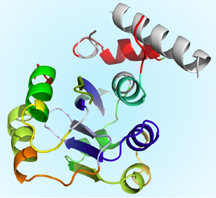Collaboration Leads to First Structure of Crucial Plant Hormone
By Eric Sauter
An international collaboration including scientists from the Florida campus of The Scripps Research Institute (TSRI) has determined the structure of a plant hormone that plays a crucial role in regulating plants’ responses to insects and disease-causing microorganisms as well as normal growth and development.
The new study, published by the journal Nature, focused on a plant hormone called jasmonate and two proteins involved in its molecular signaling, MYC and JAZ.
Previous attempts to determine a three-dimensional picture of this interaction were frustrated when scientists had great difficulties forming crystals of MYC and JAZ bound to one another—a necessary step to determine molecular structure using a high-resolution technique called x-ray crystallography.
“The outstanding question answered in the study is why the protein complex crystallization between MYC and the JAZ motif was so difficult, given the binding affinity is so tight,” said Patrick R. Griffin, chair of the Department of Molecular Therapeutics and director of the Translational Research Institute at Scripps Florida. “As a collaborative effort, the study revealed structural intricacies in the MYC factor that are highly flexible.”
The study included scientists from Michigan State University, Howard Hughes Medical Institute (HHMI), the Chinese Academy of Sciences, Zhejiang Sci-Tech University, Nanjing Agricultural University, Van Andel Research Institute, Western Michigan University and Northwestern University.
Griffin’s laboratory contributed to the study with its leading-edge expertise in HDX (short for hydrogen-deuterium exchange mass spectrometry), an advanced method of examining alterations in the dynamics of proteins and how these changes relate to protein function. With the help of HDX, the team was able to show that the structural conformation of the MYC factors changes profoundly when bound to one of the JAZ repressors. This key finding led to the making of a JAZ-MYC fusion construct, resulting in high quality crystals.
“Although the solved crystal structure of the MYC transcription factor in question only captured a snapshot of a favored conformation, it does explain nicely how the JAZ acts as a dual repressor/activator switch to the MYC,” said Vinh Q. Lam, a senior research associate in the Griffin lab who worked on the study. “The HDX studies indicate that, in solution, the regions occupied by JAZ are highly dynamic.”
Whether this flexibility is required for downstream function is not yet clear. Thus, future studies will include multiple components in experiments to elucidate the jasmonate signaling pathway.
In addition to Griffin and Lam, other authors of the study, “Structural Basis of JAZ Repression of MYC Transcription Factors in Jasmonate Signaling,” include corresponding author Sheng Yang He of Michigan State University and HHMI; first authors Feng Zhang and Jiyan Ke of the Van Andel Research Institute and Jian Yao of Michigan State; Li Zhang and Xiu-Fang Xin of Michigan State; X. Edward Zhou, Jian Chen, H. Eric Xu and Karsten Melcher of Van Andel Research Institute and the Chinese Academy of Sciences; Joseph Brunzelle of Northwestern University; and Mingguo Zhou of Nanjing Agricultural University. See http://www.nature.com/nature/journal/vaop/ncurrent/full/nature14661.html
This research was supported by the Gordon and Betty Moore Foundation (GBMF3037), the China Scholarship Council, Van Andel Research Institute, the National Institutes of Health (R01 GM102545 and R01AI060761), U.S. Department of Energy (grant DE–FG02–91ER20021, contract DE-AC02-06CH11357), Michigan Economic Development Corporation and the Michigan Technology Tri-Corridor (grant 085P1000817).
Send comments to: press[at]scripps.edu














